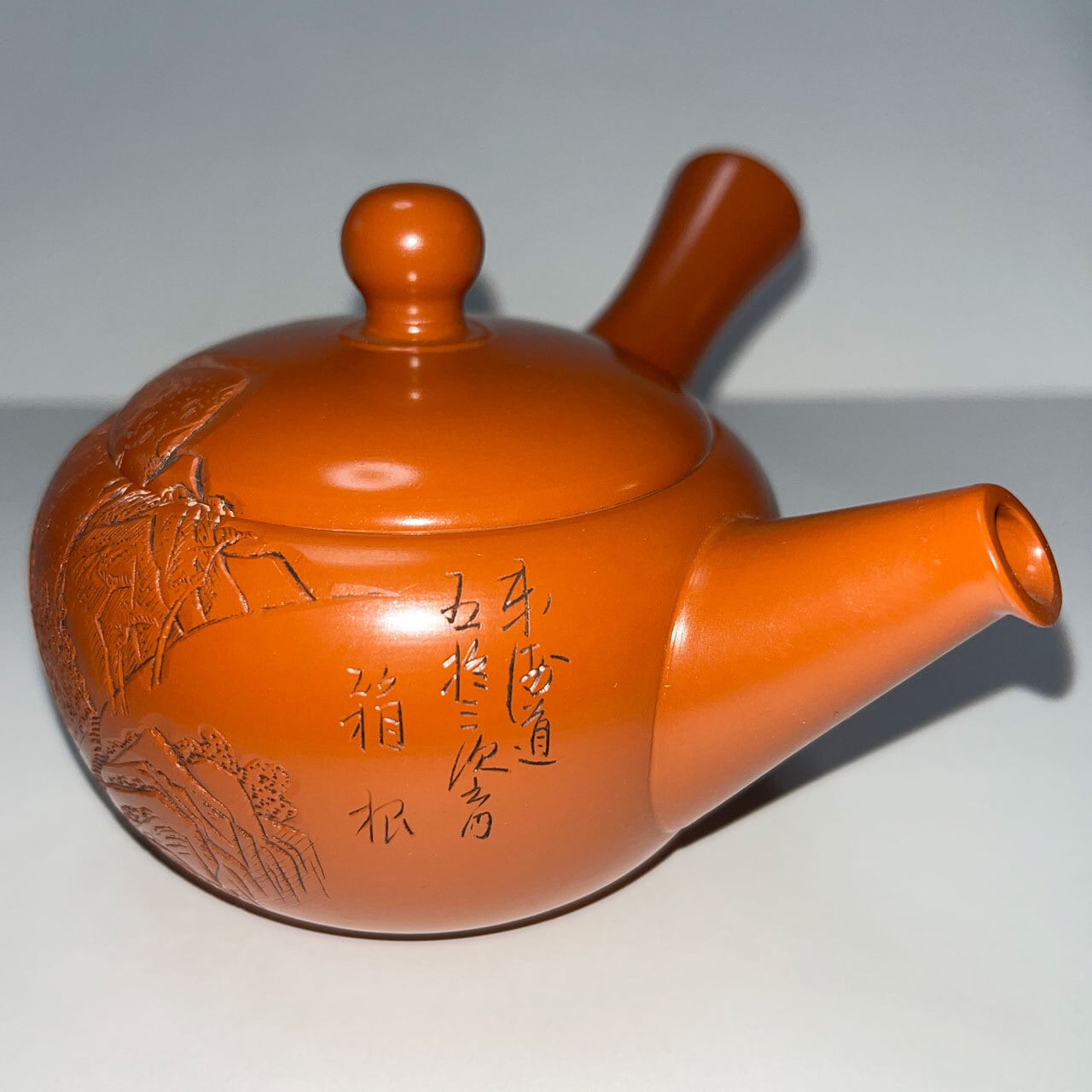







常滑焼 「東海道五十三次 箱根 湖水図」の彫刻急須 二代目間野舜園作 新品・未使用品 共箱あり / Tokoname-yaki, "Tokaido-Gojusan-tsugi, Hakone Kosui-zu", Created by Shunen Mano II, New/unused item, Original box
¥190,000 税込
残り1点
歌川広重の「東海道五十三次 箱根 湖水図」が彫刻された急須は、まさに芸術作品と言える一品です。繊細で美しい彫刻が施され、そのデザインは見る者を魅了します。二代目間野舜園による手作りで、信頼感のある技術が感じられます。
この急須は、茶の湯のひとときをより特別なものにしてくれるでしょう。常滑焼の伝統が根付くこの急須は、使用する度に心豊かにし、心の安らぎを与えてくれます。箱根の湖水図が描かれた美しいデザインは、おもてなしの際にも大変映えることでしょう。
また、急須としての機能性にも優れており、扱いやすいサイズ感と耐熱性を兼ね備えています。お茶を淹れるときはもちろん、インテリアとしても楽しむことができます。
贈り物としても喜ばれること間違いありません。この急須を通じて、日本の伝統文化に触れ、日常の中に特別なひとときを取り入れる経験をお楽しみください。
※新品・未使用品、小売店で眠っていた不動在庫(長期保管品)です。
---------------------------------
Q:常滑焼(とこなめやき)とは?
A:常滑焼は、日本の愛知県常滑市を中心とした陶磁器の伝統的な窯元です。「日本六古窯(にほんろっこよう)」(瀬戸・常滑・信楽・丹波・備前・越前)と呼ばれています。平安時代末期には、知多半島の丘陵地に常滑を中心に穴窯が広がり、山茶碗や壺などが作られました。この時代に作られた焼き物は古常滑と呼ばれます。中世常滑窯は当時最大の生産地で、大型の皿や茶碗が特徴でした。室町時代には生産が拡大し、大型の甕や壺が遠隔地へ船で運ばれました。江戸時代には真焼けの陶芸品が増え、明治時代には平地窯や機械化が導入され、食塩焼きが現れ、土管・焼酎瓶・建築陶器、衛生陶器も登場し、近代産業へ進化しました。大正から平成にかけて技術と生産が急速に進歩し、現在の状況に至りました。
Q:二代目間野舜園(まの しゅんえん)とは?
A:二代目間野舜園は、常滑焼の著名な陶芸家であり、特に急須の製作において高い評価を受けています。彼は1950年に常滑市で生まれ、父である初代舜園の指導を受けました。1974年に二代目舜園を継承し、以来、急須の製作において独自のスタイルを確立しました。彼の作品は、透かし彫りや立体的な彫刻が特徴であり、急須自体も自ら製作しています。彼は多くの陶芸展やコンテストで受賞歴があります。彼の作品は、茶道具としてだけでなく、美術品としても高く評価されています。
Q:東海道五十三次 箱根 湖水図とは?
A:「東海道五十三次 箱根 湖水図」は、本来は江戸時代の著名な浮世絵師、歌川広重によって制作された浮世絵で、1833年から1834年にかけて描かれました。この作品は、東海道の53の宿場町をテーマにしたシリーズの一部であり、特に箱根の険しい山道と美しい湖水を描写しています。広重の浮世絵作品の中でも特に評価が高く、日本文化や美術史において重要な位置を占めています。彼の作品は、単なる風景画ではなく、その背後にある物語や文化的背景をも伝えるものとして、多くの人々に愛されています。
===================
The teapot engraved with Hiroshige Utagawa(歌川広重)'s "Tokaido-Gojusan-tsugi, Hakone Kosui-zu(東海道五十三次 箱根 湖水図)" is truly a work of art. The delicate and beautiful carvings captivate the viewer. Handmade by Shunen Mano II(二代目間野舜園), you can feel the reliable technique.
This teapot will make your tea ceremony experience even more special. This teapot, rooted in the tradition of Tokoname ware, enriches your soul and gives you peace of mind every time you use it. The beautiful design depicting a map of Hakone's lakes will look great when entertaining guests.
It also has excellent functionality as a teapot, with an easy-to-handle size and heat resistance. You can enjoy it not only when making tea, but also as an interior decoration.
There is no doubt that it will be appreciated as a gift. Through this teapot, you can experience Japanese traditional culture and enjoy the experience of bringing special moments into your everyday life.
*New/unused item. This is a long-term storage item at a retail store.
---------------------------------
Q : What is Tokoname-yaki(常滑焼)?
A : Tokoname-yaki is a traditional pottery pottery centered in Tokoname City, Aichi Prefecture, Japan. At the end of the Heian period (794-1185), anagama kilns spread across the hills of the Chita Peninsula around Tokoname, known as the "Six Ancient Kilns of Japan" (Seto, Tokoname, Shigaraki, Tanba, Bizen, and Echizen). Tea bowls and pots were made. Pottery made in this period is called Ko-Tokoname. Medieval Tokoname kiln was the largest production area at that time, and was characterized by large plates and bowls. During the Muromachi period, production expanded, and large-scale jars and pots could be obtained by ship to remote areas. In the Edo era, the number of ceramics made with true ware increased, and in the Meiji period, flat kilns and mechanization were introduced, salt-grilled products appeared, clay pipes, shochu bottles, architectural ceramics, and sanitary wares appeared, evolving into a modern industry. Technology and production progressed rapidly in the future, leading to the current situation.
Q: Who is Shunen Mano II(二代目間野舜園)?
A: Shunen Mano II is a famous Tokoname pottery artist, and is especially highly acclaimed for his work in making teapots. He was born in Tokoname City in 1950 and was trained by his father, Shuen I. The second generation took over Shunen in 1974, and since then they have established their own unique style of teapot production. His works are characterized by openwork and three-dimensional carvings, and he also makes the teapots himself. He has won awards in many ceramic art exhibitions and contests. His works are highly valued not only as tea utensils but also as works of art.
Q: What is "Tokaido-Gojusan-tsugi, Hakone Kosui-zu(東海道五十三次 箱根 湖水図)"?
A: "Tokaido-Gojusan-tsugi, Hakone Kosui-zu" means Fifty-three Stations of the Tokaido Hakone Lake Map in Japanese. This was originally an ukiyo-e created by Hiroshige Utagawa(歌川広重), a famous ukiyo-e artist from the Edo period, and was painted between 1833 and 1834. This work is part of a series on the 53 post towns of the Tokaido, and particularly depicts the rugged mountain passes and beautiful lakes of Hakone. It is particularly highly regarded among Hiroshige's ukiyo-e works, and occupies an important position in Japanese culture and art history. His works are loved by many people because they are not just landscape paintings, but also convey the stories and cultural backgrounds behind them.
*"Tokaido(東海道)" is one of the major roads developed during the Edo period, and is approximately 490 kilometers long, connecting Edo (present-day Tokyo) to Kyoto. This road passed through 53 post towns (stations) and functioned as an important transportation route for travelers and merchants. Because there are 53 post towns, it is called the "Tokaido-Gojusan(53)-tsugi".
-
送料・配送方法について
-
お支払い方法について





























